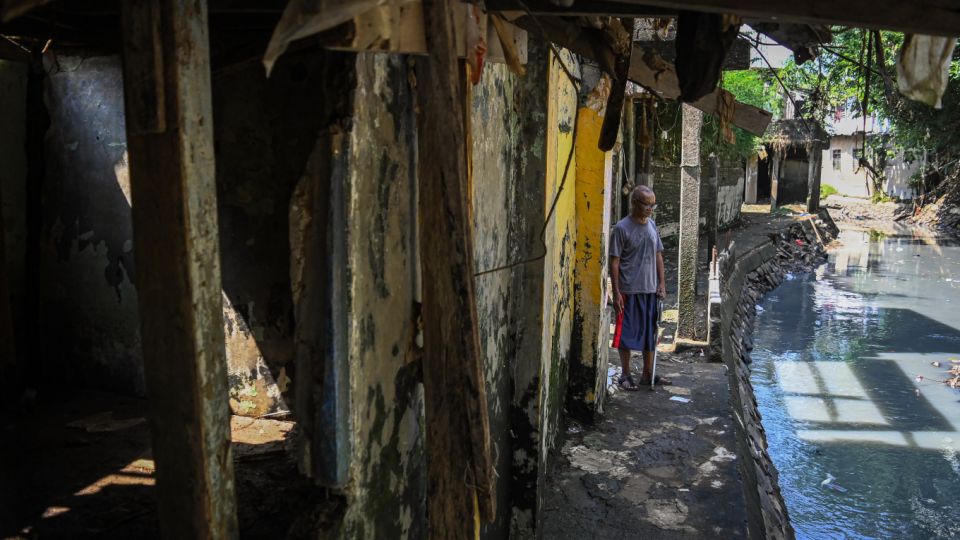July 22, 2024
JAKARTA – Amid the hustle and bustle of the Cililitan Wholesale Center (PGC) in East Jakarta lies an abandoned settlement known as Kampung Zombie.
The village is less than 500 meters from the PGC intersection, sitting lower than its surrounding area and hidden behind the steep Al-Hikmah alley next to Pertiwi University on Jl. Dewi Sartika.
Dozens of abandoned houses line the banks of Kali Item (Black Stream), a distributary of the Ciliwung River; the name refers to its dark color resulting from water pollution. Mud covers the floors of the empty houses where the roofs have collapsed and the walls are peeling.
Head of the neighborhood unit (RT) Nur Hidayat said the village got its nickname “Zombie” in around 2015 as it became deserted with residents leaving due to repeated heavy floods.
“Initially, the name was a joke. This village is very quiet, it’s like a zombie kampung,” said the 53-year-old.
“You are the zombie,” a resident who was playing chess at Nur’s house chimed in.
Nur said that the area was once densely populated with 33 families and scores of outsiders who rented locals’ houses and rooms, but now less than half of them remain.
He shared how severe floods had hit the neighborhood several times, particularly in 2009 and 2014 when water rising up to seven meters high inundated the settlements. The flooding badly damaged people’s belongings and disrupted their daily lives, forcing them to eventually move out.
“They were tired as the floods became more frequent. Some residents rented houses nearby, and some moved to Bekasi [in West Java] and other places,” Nur went on.
“I also want to move, if possible, to Pondok Indah [an elite residence in South Jakarta]. But I don’t have the money. This house is also not selling well,” Nur said jokingly.
Every time heavy rain comes, the remaining residents monitor Kali Item and stay on the second floor of their properties for safety. When the volume of water reaches an alarming level, they evacuate to the Pertiwi University hall around 100 m from the settlements.
Climate change
The country should have entered the dry season in April, but even in July, heavy rain has fallen several times, with some neighborhoods in the packed capital becoming inundated, including the so-called Kampung Zombie, which saw severe floods on May 25 and earlier this month.
The Meteorology, Climatology and Geophysics Agency (BMKG) explained that the unusual heavy rain was caused by the Madden-Julian Oscillation intraseasonal tropical climate variability, coupled with equatorial Kelvin and Rossby waves and warmer sea surface temperatures that cause more clouds to build up in parts of the country and produce anomalous rainfall patterns.
The agency has warned people, particularly those living near rivers and in hilly areas, of possible flash floods and landslides after heavy rain.
Nur said that in addition to the weather anomalies, the pile-up of trash on the bed of the stream had also exacerbated the situation. “Kali Item was once five meters deep, but today barely one meter remains. I hope the Jakarta administration can carry out river dredging soon to alleviate the flood”.
Was beautiful
Living his whole life in the neighborhood, 63-year-old resident Das said that in the 1980s, the area was once beautiful with flowers and grass growing along the riverbank. People often went fishing there and washed away their sweat from the heat in the clean water.
It has always been a busy district for its strategic location. Before the development of the PGC in the 2000s, the shopping center site was used for the Cililitan bus station until 1986. The terminal was then demolished with a newer, bigger facility built in nearby Kampung Rambutan.
“The flooding first occurred in 1996 and gets worse every year […] I hope that the Jakarta administration can resolve the problem,” Das said.
A member of the Jakarta City Council Commission D overseeing development and infrastructure planning, Abdurrahman Suhaimi, called on the local government to step in immediately.
“The issues must be handled thoroughly; either by freeing up residents’ land and turning it into a park, or resolving the frequent floods so that residents can continue to live there,” he told The Jakarta Post on Tuesday.
A top official from the Jakarta Water Resources Agency, Hendri, said his ranks had carried out a field analysis and listened to residents’ input on the specific issues in Kampung Zombie.
“We are currently dredging the river and cleaning the surrounding water channels [particularly near the PGC],” Hendri told the Post on Tuesday.
He added that the agency was also reviewing residents’ requests for the construction of sheet piles along the riverbank.
The Post also contacted the Jakarta Housing Agency on the possibility of transforming the area into a park or developing it into a much safer settlement, but no one was immediately available for a response.


